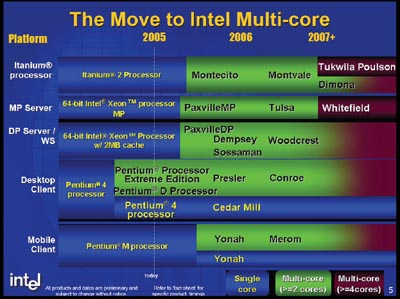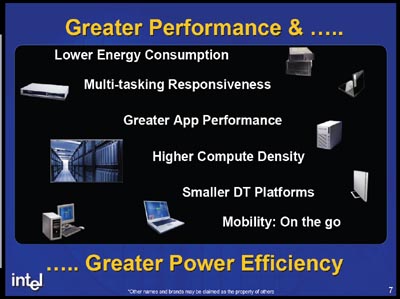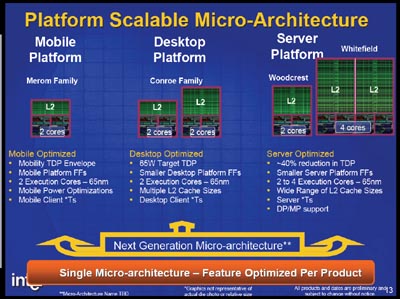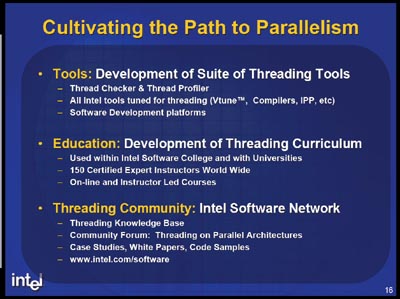Continuing our IDF coverage with some retrospective content, we've obtained the slides from Intel's Multi-Core briefing. So let's take a closer look at what their plans are.
The first thing to note is that that Intel isn't just going for multi-core desktop and server processors. They're looking to create multi-core platforms across the board, tailored to suit user needs. That starts at the top with Itanium and goes right down to mobile clients.
By the end of 2005 and into the beginning of 2006 we'll see dual-core across the board, with 4+ core solutions making an appearance in roughly two years time.
With some 15 multi-core projects on the go, Intel sees multi-core being practically everywhere within the next couple of years. The server market will see the fastest multi-core uptake, with a predicted 100% of Intel powered servers shipping with multi-core processors by the end of 2007. Mobile and desktop performance parts sit roughly 10% behind the server market.
The key thing to note about this August's IDF is that Intel has quite clearly turned away from its MHz chasing days, seeking out new ways to deliver performance to users. Performance isn't the only thing on their mind either. Heat output and power consumption have become growing concerns for both mobile, desktop and server platforms, so Intel is leveraging multi-core processors as a means of tackling all of these problems.
We're all multitaskers now, whether we're crunching data sets in the datacenter, or on the move with our laptop. Multi-cores provide faster application response in a multitasking environment. The number of processing units you can fit into a particular space increases, good news for datacenters and of course the Blade server.
We've already reported on Intel's New Architecture Plans. It will still be compatible with IA-32, but the new micro architecture aims to provide optimisations for server, desktop and mobile platforms. You'll find features from both the NetBurst (P4/Xeon) and Banias (Pentium M) mArches, along with new innovations that Intel are working on, in the new next gen mArch. Intel is keen to push that their development will follow the needs of the user.
In performance terms, looking at processing power, 2H 06 should see double the performance of existing Intel products. Look then at performance per watt, and Intel say we're looking at a 3.5X increase; they really do want more power efficient products!
The features of Intel's new mArch that will be put into new products depend on the purpose of that product. So your mobile platform will see 65nm dual-core implementations with shared L2 cache and mobile power omtimisations. Jump up to the server market and you've got two to four cores on a 65nm process, with varying levels of L2 cache.
Of course, all of these wonderful optimisations and the shift towards parallelism is next to useless without software to take advantage of it. Intel has various means to leverage this, from alliances with big software vendors, to advanced technical training. Their own software tools are also designed to provide a boost to software performance.
Looking at Intel's manufacturing trends, the transition to 90nm completes in 2005 and the focus on 65nm begins. They say that the ramp up of 65nm part production will be quicker than that of 90nm parts, so we can expect the shift to 65nm Intel products to be quite rapid once things kick off. Intel are also constructing new factories for 300mm wafer production. With 4 running now and 3 more to go online within the next two years, Intel say they're well equipped for volume shipments.
So, Intel seem to be putting everything to place. They have a multi-core roadmap which they say they are on track with, a new micro-architecture with efficiency in mind, they have initiatives to allow software makers to benefit from the new processors and they're gearing up for volume 65nm production. It's all looking good. Then again, you're always going to leave IDF with that impression.

















